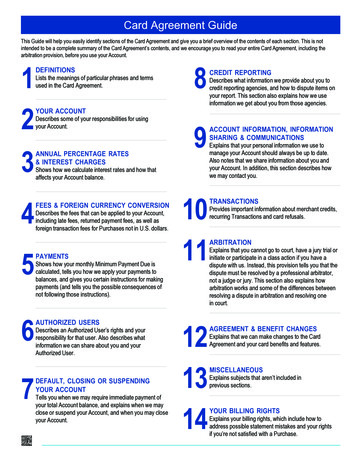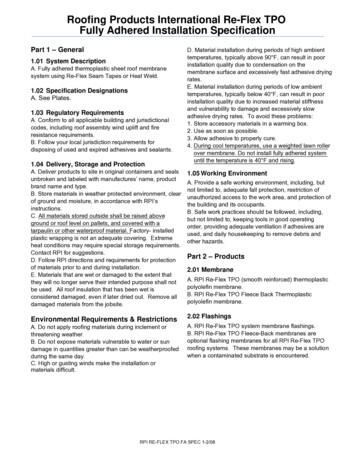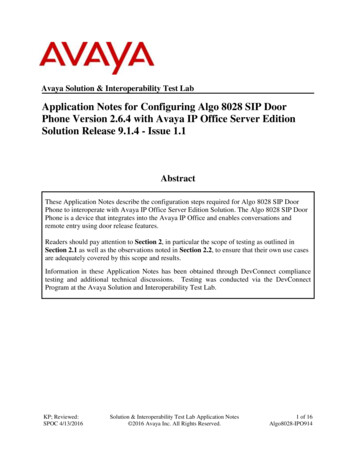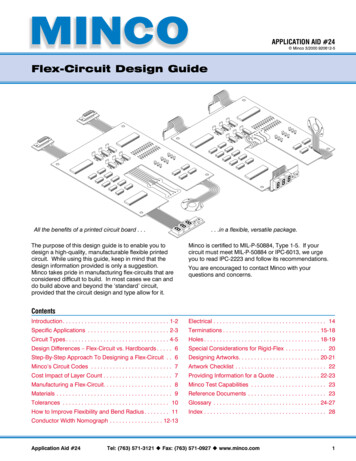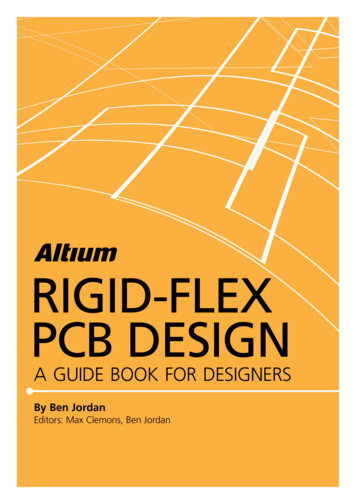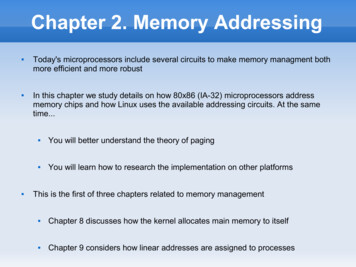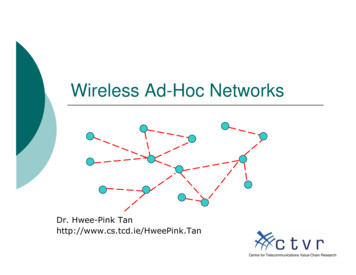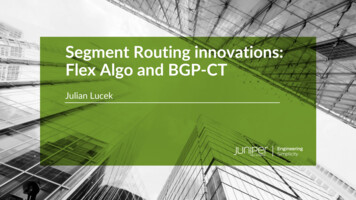
Transcription
Segment Routing innovations:Flex Algo and BGP-CTJulian Lucek 2021 Juniper Networks1
SEGMENT ROUTING (SR) LANDSCAPESRShortest PathRoutingLDPinterworkingFlex NetworksFastConvergence(TI-LFA) 2021 Juniper E)2
Flex Algo 2021 Juniper Networks3
P5FLEX-ALGOP1P3PE3PE1PE2 PE4P2P4A node can be a member of multiple algos.A node announces a different node SID for each algo that it is a member of.Separate Shortest Path First (SPF) calculations per algo.In the diagram, all nodes are members of the Grey topology. Nodes in one planeare members of Red algo, nodes in the other plane are members of the Blue algo. 2021 Juniper NetworksLo0: 10.0.0.3BLUE SID 1003GREY SID 3003Lo0: 10.0.0.4RED SID 2004GREY SID 30044
P5FLEX-ALGOP1P33003PE3PE1PE2Lo0: 10.0.0.3BLUE SID 1003GREY SID 3003PE4P2P4Lo0: 10.0.0.4RED SID 2004GREY SID 3004“Vanilla” traffic from PE1 is mapped to Grey topology, cango anywhere 2021 Juniper Networks5
P5FLEX-ALGOP1P31003PE3PE1PE2 PE42004P2P4We have some traffic from PE1 to PE3 that needs to bediversely routed from other traffic from PE2 to PE4Use Blue and Red algos respectively 2021 Juniper NetworksLo0: 10.0.0.3BLUE SID 1003GREY SID 3003Lo0: 10.0.0.4RED SID 2004GREY SID 30046
ANOTHER FLEX-ALGO EXAMPLENodes and links can be members of multiple flex-algosPhysical E2P3 2021 Juniper NetworksP4Flex-algo 1P2P1PE3P5P3Flex-algo 2P47
METRIC ACCORDING TO TRAFFIC TYPEAnother application for flex-algo is a situation where different traffic types need touse different link metrics.For example, for delay sensitive traffic, you want a metric proportional to thelatency of the link.For bulk internet traffic, you want a metric inversely proportional to the bandwidthof the link.In a given network, the two requirements might conflict! 2021 Juniper Networks8
METRIC ACCORDING TO TRAFFIC TYPEP1PE15 550 8201020102010PE25 5P3P22010P550 820105 5PE32010PE45 5P4Normal IGP metric in blue font. Bulk traffic uses the normal IGP.Red flex-algo metric in red font. Delay-sensitive traffic uses the red flex-algo.In this example, all routers are members of the normal IGP and the red flex-algo. 2021 Juniper Networks9
METRIC ACCORDING TO TRAFFIC TYPEP1PE15 5PE25 5P3 2021 Juniper Networks50 8201020102010P22010P550 82010Flex-algo shortest-path5 52010PE3Normal IGP shortest-pathPE45 5P410
FLEX-ALGO USING DELAY-METRIC In the IGP, on each interface configure a delay-metric (as well as the normal IGP metric). The delay metric can either be static, or can be automatically derived from live TWAMPprobe packet measurements. Configure the flex-algo to use the delay metric.set routing-options flex-algorithm 129 definition priority 100set routing-options flex-algorithm 129 definition metric-type delay-metricset routing-options flex-algorithm 129 color 129 In general, a flex-algo can be configured to use one of these metric-types: normal IGP metric TE-metric delay-metric 2021 Juniper Networks11
MAPPING TRAFFIC TO THE PREFERRED TRANSPORTColors provide a convenient way to auto-map prefixes/servicesto a particular transportFor example, mapping a particular VPN to a particular type ofTE-tunnel or to a particular Flex-Algo.It’s a very versatile approach, and also plays an important partin BGP-CT (see later) 2021 Juniper Networks12
AUTO-MAPPING OF COLORED PREFIXES ONTO COLOREDTUNNELS10.1/16, color community 100, nh PEY10.2/16, color community 100, nh PEYPEXRed Flex-Algo,color 100Blue Flex-Algo,color 200PEY11.1/16, color community 200, nh PEY11.2/16, color community 200, nh PEY A prefix (e.g. plain IP or VPN prefix) with a color community is automatically mapped onto theflex-algo with the matching color.Can also be used to map traffic onto a colored TE Tunnel (SR-TE or RSVP-TE). 2021 Juniper Networks13
SLICING ACROSS TELCO CLOUD AND TRANSPORT cost LSPServersMPLS over UDPSpinelayerLeaflayerRDCDC-GW1DC-GW2Low latencyLSPTransportNetworkMPLS over UDPSpinelayerLeaflayerEDC Traffic from green and purple overlay networks (slices) need minimum cost transport. Traffic from yellow overlay network (slice) needs minimum cost transport. 2021 Juniper NetworksServers
ControlplanePrefix: cNF2ContrailController 1Color community: 200XMPPDC2Next hop: vR2Route Target: XRoute Target: XColor community: 200Color community: 200BGPBGPGreenVRFTNDCGW1vRouter1Color PBGPColor 100GreenVRFForwardingplaneVPN Label: V2Next hop: DCGW2Route Target: XContrailController 2Prefix: cNF2VPN Label: V2’Next hop: DCGW1DC1cNF1Prefix: cNF2VPN Label: PLSoUDPKey point: DCGW1 puts the traffic for cNF2 onto the Flex-Algo or TE-LSPthat has color 200, because the BGP prefix has color community C200. 2021 Juniper Networks
BGP ClassfulTransport (BGP-CT) 2021 Juniper Networks
BGP CLASSFUL TRANSPORT (BGP-CT)A mechanism for extending color-mapping across multiple ASes.No need to expose internal topology of a domain to any other domain.Each domain can make its own choice of transport technology independently of what otherdomains are usingRSVP-TE/SR-TE, with or without controller, Flex-Algo,BGP-CT acts as the “glue” between domainsBGP-CT is similar to BGP-LU, except that it has {egress PE, color} granularityColor denotes the “flavor” of the transport e.g. minimum latency, cheapest monetary cost.See -bgp-classful-transport-planes/ 2021 Juniper Networks17
BGP-CT PE1 maps prefixes (according to color community) to the matching color BGPCT label and local tunnel or flex-algo to ASBR1.In turn, ASBR2 maps traffic to tunnel or flex-algo to ASBR3 according to thecolor of the incoming BGP-CT label.BGP-CT:10.0.0.1/32:Color 100, Label L1Color 200, Label L2ASBR1ASBR2Color 100Color 100PE1Color 200AS1Color 200AS2ASBR3ASBR4Color 100Color 200PE2: 10.0.0.1AS3e.g. Color 100 cheapest costColor 200 minimum latency 2021 Juniper Networks18
FURTHER raft-ietf-lsr-flex-algo/BGP Classful Transport iraj-idr-bgp-classful-transport-planes/Blog about Differentiated Transport for Cloud Overlay ossthe-wan-for-cloud-overlay-networks 2021 Juniper Networks19
Thank you 2021 Juniper Networks20
BGP-CT: Color 100 Color 100 Color 100 Color 200 Color 200 Color 200 PE1 maps prefixes (according to color community) to the matching color BGP-CT label and local tunnel or flex-algo to ASBR1. In turn, ASBR2 maps traffic to tunnel or flex-algo to ASBR3 according to the color of the incoming BGP-CT label.
